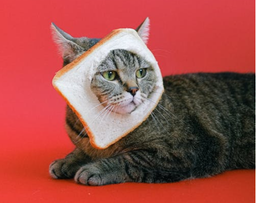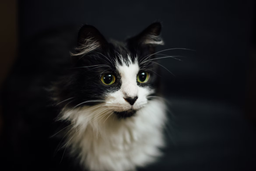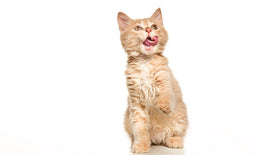A fat cat chart—monitor your feline’s weight with Untamed!
Cats may look cuddly if they are a little on the plump side, but being overweight is not the healthiest way to live.
A combination of too much food—dry, semi-moist, homemade, raw, or wet—and too little exercise can turn your cat into a chonk.
The weight gain in adult cats doesn’t happen overnight. You may only notice that your feline has put on too much poundage when the excess weight leads to a secondary problem or illness. In such cases, drastic action is required to help your kitty return to a healthy weight.
To keep your feline fit, you should check their weight regularly and adjust their diet accordingly.
An easy way to keep tabs on weight is to make a fat cat chart—Untamed explains how to do it efficiently!

“So what if I look like a sheep? They are cooool!”
Source: Pixabay
Why are cats fat?
Cats are designed to be hunters, and their natural daily routine consists of:
- Energy expenditure through hunting
- Energy intake from eating prey
- Regaining energy through rest
A feline’s diet in the wild comprises birds, rodents, and lizards, none of which provide much nutrition in one go. A wild cat will hunt up to twenty times a day to get enough nutrients. Consequently, wild cats seldom struggle with weight problems. Domestic felines often eat large amounts of food once or twice a day, without feeling the need to move as their cat parents provide the meals.
Factor into this that many commercial cat foods are full of carbohydrates, and gaining weight is almost inevitable for indoor kitties.
Carbs come in three forms:
- Simple carbs, such as sugar
- Medium-chain carbs, known as starches
- Complex carbs, or fibre
As obligate carnivores, cats have not evolved to metabolise large volumes of sugar or starch. While some fibre may have a beneficial effect on your cat’s digestion, most carbs deliver fast-burn calories that:
- Provide short-term energy
- Put pressure on the pancreas to control blood sugar levels
- Are stored as fat if the energy is not burned quickly
Any food with too many calories is likely to:
- Cause lethargy immediately after eating as your cat’s body struggles to manage blood-sugar levels
- Lead to weight gain
What is a healthy weight for a cat?
A healthy weight for domestic cats depends on their size, but the basic rule of thumb is that an average adult feline should weigh around 4.5 kilograms.
Certain breeds will have a different ideal weight, dependent on their typical body mass and build. Check out the following table for details:
|
Cat breed |
Ideal adult weight |
|
3–6.5 kg |
|
|
3–6 kg |
|
|
5–11.5 kg |
|
|
4–7 kg |
|
|
3.5–8 kg |
|
|
3.5–6 kg |
Keep in mind that every feline is unique. Your cat’s metabolism might be slower, so their weight loss or gain can be affected by various factors, including their lifestyle and sterilisation status. Your best bet is to create a personalised fat cat chart to monitor your feline's weight monthly. You will be able to spot fluctuations and act accordingly before it’s too late.
How can a fat cat chart help you control your feline’s weight?
Keeping a close eye on your kitty’s weight can help you:
- Spot fluctuations quickly
- Assess the effectiveness of a particular diet
- Notice potential health issues
Spot fluctuations quickly
Minor variances (around 100 grams monthly) are generally nothing to worry about, but a gain of 500 grams for a 5-kilogram cat is a weight gain of 10%.
It should be cause for concern, and you may need to act quickly to keep your kitty from becoming a Garfield. Gaining weight can cause your cat to become lethargic, which makes them move less and eventually leads to obesity.
Assess the effectiveness of a diet
If you are already controlling your feline’s weight with a strict food regimen, regular weighing will help you assess whether the diet works.
It is worth remembering that a visual inspection may not be enough to determine how much your cat has slimmed down.
If your feline has been overweight for some time, excess skin may have developed, masking how much fat they have lost.
Noticing potential health issues
Rapid weight gain or loss can be a symptom of several serious health issues. The sooner you can spot nascent health problems, the quicker you will be able to consult a vet to get treatment. Obesity can lead to diabetes, hyperthyroidism, and heart disease.
What should a fat cat chart look like?
You should create a simple chart that records your cat’s weight progression each month. Don’t over-complicate the process because your chart needs to be straightforward. The data you need to collect is as follows:
|
Date |
Weight in kg |
Average feeding amount per day and the type of food consumed |
Activity level points from 1 to 5 (1 = low activity, 5 = high activity) |
|
March |
5.7 |
600g dry kibbles |
1 |
|
April |
5.6 |
3 tin of wet food |
2 |
|
May |
5.4 |
2 tins of wet food |
3 |
|
June |
5.3 |
2 tins of wet food |
4 |

“You really think I’m going to willingly get on those scales?”
Source: Pixabay
How to weigh your cat properly
Even if you can get your feline to stand on your bathroom scales long enough, you may find that the reading is too inaccurate—a variance of 500 grammes is a major change for a cat.
You can buy pet-specific scales or devices designed to weigh babies. These are generally inexpensive and sensitive enough for you to track your kitty’s weight loss accurately.
If you don’t fancy regular weighing, you can make a regular visual inspection of your feline to chart body shape and fat levels. These are measured on a nine-point scale, with one being underweight and nine obese.
The markers you should check are as follows:
|
Body condition score (BCS) |
Condition |
Explanation |
Appearance |
|
Grades one to three |
Too thin |
|
 |
|
Grades four to five |
Ideal |
Cats graded four to five:
|
 |
|
Grades six and seven |
Overweight |
|
 |
|
Grades eight and nine |
Obese |
|
 |

“I’m a BCS10, me!”
Source: Pixabay
Should you be worried about your overweight cat?
Many cat parents view their chubby cats as cuddly or well-built without realising the potential health implications of being overweight.
Weight issues can have both short- and long-term effects on your feline’s health, and the most common are:
- Risk of arthritis and skeletal issues
- Diabetes and pancreatitis
- Heart issues
- Hypertension and stroke risk
Risk of arthritis and skeletal issues
Cats’ joints are only designed to carry a certain amount of weight.
If a cat spends months or years carrying additional weight, joints can be placed under excessive strain. Overweight cats are less mobile, particularly as they reach an advanced age, and felines must move to keep their bones and joints healthy. The best way to help your senior cat stay fit is to monitor and control weight in their adult phase.
Diabetes and pancreatitis
There is a proven link between being overweight and the development of diabetes in cats. A carb-rich diet can flood your cat’s body with sugar, causing the pancreas to strain to produce enough insulin to keep blood sugar levels in check.
Constant strain on the pancreas can cause the inflammation of this vital organ, which affects the digestive tract and insulin production. Resulting diabetes can only be managed with regular insulin injections, which is an uncomfortable and expensive process.
Heart issues
The heart muscle of obese cats eventually becomes incapable of pumping enough blood to supply a cat’s body. The condition is known as cardiomyopathy.
The symptoms of this disease are:
- Lethargy
- Breathing difficulties
- Acute paralysis, particularly in the hind legs
- Seizures
Hypertension
Elevated blood pressure in your cat can increase the risk of heart failure and stroke, both of which can prove fatal.
While hypertension is often caused by an underlying condition, such as thyroid or kidney insufficiency, its effects are worse if the affected cat is overweight.
What can you do if your kitty is off the cat fat chart?
The keys to any successful diet are:
- Healthier food
- More movement
Healthier food
The ideal diet for a cat consists of:
- Animal protein for muscles and organ health
- Fat for taste and proper nutrient transportation
- Vitamins and minerals for efficient metabolism
Any other ingredients are unnecessary, so you should make sure that your feline’s diet is grain-free and as low in carbohydrates as possible.
Several dietary choices have become popular in recent years, such as:
Each option adheres to the principle that a cat’s diet should be as close as possible to what felines eat in the wild—meat, animal fat, and not much else.
Vegetarian or vegan diets, while acceptable for humans, do not provide adequate nutrition for felines.
More movement
Cats are naturally playful creatures—you only need to watch kittens learning to hunt through play to see this.
As a cat parent, you can encourage your sedentary kitty to be more active. Here are some handy tips to prompt your kitty to move:
- Set playtime sessions at regular intervals every day
- Invest in some high-quality hunting toys or a laser pointer
- Move the food bowl around, so your cat needs to hunt for it
When encouraging your kitty to play, remember that cats are creatures of habit. Don’t cause stress by forcing too much activity—this could have the opposite effect of sending your cat scurrying into the nearest cupboard to hide.
What diet changes can you make to help your cat lose weight?
If you want to switch your cat to a healthier diet to encourage weight loss, consider the following advice:
- Choose food with high animal protein levels
- Look for products with simple, concise ingredient lists
- Pay attention to your cat’s taste
Food with high animal protein levels
Whole meat in your cat’s food provides the protein needed for:
- Muscle tone
- Skin health
- Organ function
As carnivores, cats are best at metabolising animal protein. They can digest some vegetable protein sources but need to eat more to satisfy their nutritional needs. The amino acid profile in plant protein is not appropriate for felines, and they won’t get all the essential micronutrients from veggies and fruits like they would from poultry and fish.
The quality of protein sources is measured by their biological value (BV), which indicates what percentage of each protein a cat can metabolise.
The most common protein sources in cat food and their BVs are:
|
Protein source |
Biological value |
|
98% |
|
|
94% |
|
Liver |
92% |
|
87% |
|
|
Soya |
68% |
|
Below 65% |
The higher the BV of the main ingredient in cat food, the less your cat will have to eat to be healthy and active.

The best protein offers the best way to get your kitty’s weight under control.
Image (c) Untamed
Look for products with simple and concise ingredient lists
If you can’t understand or pronounce the ingredients in cat food, you can’t tell whether or not it is good.
Many commercial cat food manufacturers boost the nutritional value of their product by using artificial additives, flavour enhancers, and agents to make it look or taste better.
For example, you may find taurine listed as an ingredient in dry or semi-moist cat food. Taurine is found in sufficient quantities in all forms of meat, so its inclusion as a separate ingredient suggests that the product doesn’t contain enough meat to cover your cat’s requirements.
Pay attention to your cat’s taste
Cats love the taste of animal fat, but they are also sensitive to how food feels in their mouth.
Several factors can influence how amenable your cat is to healthier food:
- Dental issues may cause your cat to shy away from dry food and prefer it mixed with wet or softened in a broth or soup
- If your cat associates a particular taste with previous gastro problems or food sensitivity, you may need to choose a different flavour
- Some cats prefer the feel of crunchy dry food to wet, although this is uncommon
Your safest bet is to dish up quality food with high quantities of real meat, tasty animal fat, and no unnecessary extras.
Untamed helps keep your feline trim and slim
When it comes to making your chonk look like a panther, Untamed ticks all the boxes.
Every dish gives your cat whole meat in rich gravy or jelly, so delicious it’ll drive even the fussiest felines wild.
On top of tasty and healthy recipes, Untamed sticks to:
- Human-grade ingredients
- Exclusively animal protein sources
- Vet-formulated recipes
Human-grade ingredients
Every ingredient in Untamed cat food is of human-grade quality, so you can be sure that your kitty is getting only the best. We gently steam our meals to preserve the aroma intact.
Exclusively animal protein sources
We don’t use animal derivatives or byproducts, and we steer well clear of vegetable proteins and grains.
Your cat will only get the best protein sources in Untamed tins, promoting health and longevity from the first bite to the last.
Vet-formulated recipes
Our recipes are inspired by homemade food but have been honed and refined by vets. Every Untamed tin contains exactly what your cat needs, no more and no less.
Switching over to Untamed doesn’t only enable you to manage your feline’s weight. High-quality nutrition can also help with:
- Shedding and hairballs
- UTIs, such as cystitis and bladder stones
- Food allergies, nausea, and loss of appetite
- Raising healthy kittens, including managing their growth and avoiding diarrhoea
- Keeping senior cats healthy and active
Let your chonk try Untamed, and watch them shed those extra pounds in no time.

Untamed is all your cat needs for health and longevity
Image (c) Untamed
Getting Untamed is so easy!
You don’t have to go hunting for Untamed—our tailor-made cat food can be ordered online! To get your feline slimming journey underway, here’s what you need to do:
- Tell us about your cat
- Pick a suitable meal plan
- Order your first trial pack
If your kitty likes our dishes, we will replenish your supplies every month around the same time. Our delivery service for cat food is adjustable—you can make the necessary changes to your monthly supplies from your account.
The timeline of the Untamed effect is as follows:
- Within a week—Your cat should be more active and have better digestion
- After a month—Fat should gradually turn into muscles
- Within four months—Your cat’s coat should appear sleeker and healthier
- For life—There’ll be no weight problems because of proper nutrition and impeccable digestive tract health

![Best food for Ragdoll cats in the UK [Broken Down]](http://untamed.com/cdn/shop/articles/featured_best_food_for_ragdoll_cats_uk.jpg?v=1646818249&width=256)

